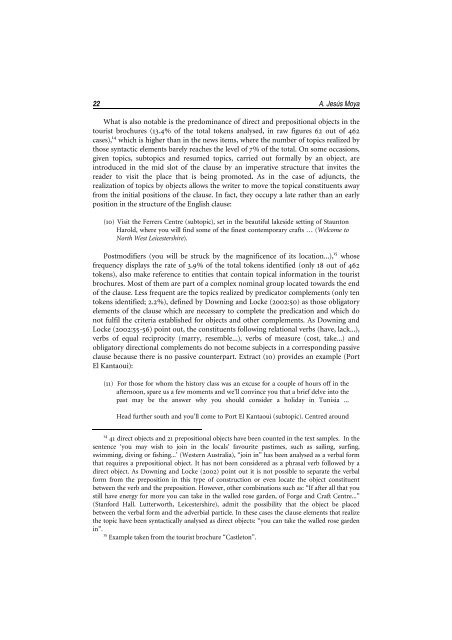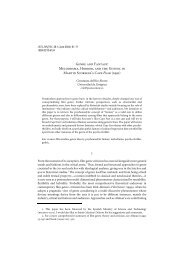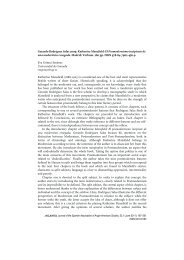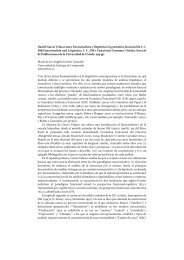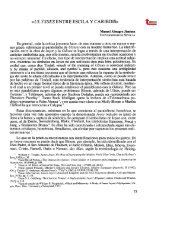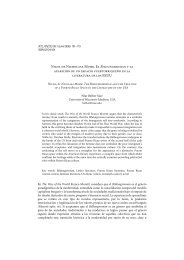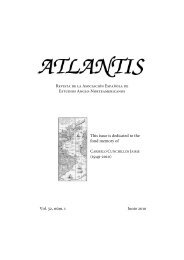On Pragmatic Functions and their Correlation with Syntactic - Atlantis
On Pragmatic Functions and their Correlation with Syntactic - Atlantis
On Pragmatic Functions and their Correlation with Syntactic - Atlantis
Create successful ePaper yourself
Turn your PDF publications into a flip-book with our unique Google optimized e-Paper software.
22 A. Jesús Moya<br />
What is also notable is the predominance of direct <strong>and</strong> prepositional objects in the<br />
tourist brochures (13.4% of the total tokens analysed, in raw figures 62 out of 462<br />
cases), 14 which is higher than in the news items, where the number of topics realized by<br />
those syntactic elements barely reaches the level of 7% of the total. <strong>On</strong> some occasions,<br />
given topics, subtopics <strong>and</strong> resumed topics, carried out formally by an object, are<br />
introduced in the mid slot of the clause by an imperative structure that invites the<br />
reader to visit the place that is being promoted. As in the case of adjuncts, the<br />
realization of topics by objects allows the writer to move the topical constituents away<br />
from the initial positions of the clause. In fact, they occupy a late rather than an early<br />
position in the structure of the English clause:<br />
(10) Visit the Ferrers Centre (subtopic), set in the beautiful lakeside setting of Staunton<br />
Harold, where you will find some of the finest contemporary crafts … (Welcome to<br />
North West Leicestershire).<br />
Postmodifiers (you will be struck by the magnificence of its location...), 15 whose<br />
frequency displays the rate of 3.9% of the total tokens identified (only 18 out of 462<br />
tokens), also make reference to entities that contain topical information in the tourist<br />
brochures. Most of them are part of a complex nominal group located towards the end<br />
of the clause. Less frequent are the topics realized by predicator complements (only ten<br />
tokens identified; 2.2%), defined by Downing <strong>and</strong> Locke (2002:50) as those obligatory<br />
elements of the clause which are necessary to complete the predication <strong>and</strong> which do<br />
not fulfil the criteria established for objects <strong>and</strong> other complements. As Downing <strong>and</strong><br />
Locke (2002:55-56) point out, the constituents following relational verbs (have, lack...),<br />
verbs of equal reciprocity (marry, resemble...), verbs of measure (cost, take...) <strong>and</strong><br />
obligatory directional complements do not become subjects in a corresponding passive<br />
clause because there is no passive counterpart. Extract (10) provides an example (Port<br />
El Kantaoui):<br />
(11) For those for whom the history class was an excuse for a couple of hours off in the<br />
afternoon, spare us a few moments <strong>and</strong> we’ll convince you that a brief delve into the<br />
past may be the answer why you should consider a holiday in Tunisia ...<br />
Head further south <strong>and</strong> you’ll come to Port El Kantaoui (subtopic). Centred around<br />
14 41 direct objects <strong>and</strong> 21 prepositional objects have been counted in the text samples. In the<br />
sentence ‘you may wish to join in the locals’ favourite pastimes, such as sailing, surfing,<br />
swimming, diving or fishing...’ (Western Australia), “join in” has been analysed as a verbal form<br />
that requires a prepositional object. It has not been considered as a phrasal verb followed by a<br />
direct object. As Downing <strong>and</strong> Locke (2002) point out it is not possible to separate the verbal<br />
form from the preposition in this type of construction or even locate the object constituent<br />
between the verb <strong>and</strong> the preposition. However, other combinations such as: “If after all that you<br />
still have energy for more you can take in the walled rose garden, of Forge <strong>and</strong> Craft Centre...”<br />
(Stanford Hall. Lutterworth, Leicestershire), admit the possibility that the object be placed<br />
between the verbal form <strong>and</strong> the adverbial particle. In these cases the clause elements that realize<br />
the topic have been syntactically analysed as direct objects: “you can take the walled rose garden<br />
in”. 15 Example taken from the tourist brochure “Castleton”.


